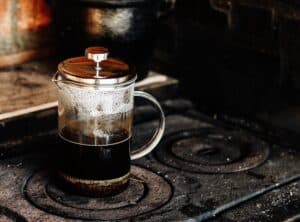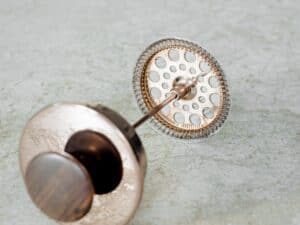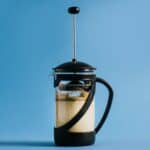13 Common French Press Mistakes to Avoid Them

Table of Contents
ToggleA French press is a humble, but well loved coffee brewing device that is used all over the world. However, many people don’t get the best results out of their French Press (or cafetiere as it is often referred to) and can make the common mistakes listed below.
In this article, I will break down 13 of the most common French press mistakes and how you can avoid them!
What is a French Press?
A french press is a coffee brewing device that uses a mesh strainer and plunger to separate ground coffee from your cup. Coarsely ground coffee beans and boiling water are added to the glass container, and the mesh plunger slides down into the glass, acting as a strainer so no ground coffee ends up in the serving cup.
A french press is a very simple device to operate, thanks to its lack of parts! All you need is ground coffee, boiled water and the french press itself. No filter papers or fancy gooseneck kettles required!
13 French Press Mistakes to Avoid Them

So, here are 13 of the most common mistakes made by home coffee brewers when using their beloved French Press!
1. Not Letting Your Coffee Brew Long Enough
The first mistake that so many people make when brewing coffee in a French press, is not actually brewing for long enough. Bear in mind, that French presses use immersion rather than percolation to extract all of those delicious coffee flavours.
This means, the coffee grounds and hot water all mingle together at the same time throughout the brew, rather than simply pouring water over a bed of grounds or forcing hot water through an espresso puck.
Therefore, more time is needed to get all of those coffee oils, compounds and aromas out of the grounds and infused into the water. Since gravity isn’t working for you in a French press, more time is needed for the perfect brew.
Rather than giving it a couple of minutes and plunging away, let your coffee sit for at least 10 minutes (closer to 15 if you are using a coarser grind and making coffee for a larger audience).
This will ensure you extract as much coffee flavour from your ground beans as possible, without over extracting and making a bitter brew!
2. Serving Your Coffee Too Slowly
Whilst the French press is a very forgiving method of brewing coffee, if you leave it to sit for too long after the grounds have been steeped, you’ll end up with a bitter after taste.
Whilst you want to give your coffee plenty of time to extract and brew in the first place, make sure to serve as soon as it’s done so you can enjoy the strong flavours without letting it over extract!
3. Using Stale Coffee
Another mistake that people often make (usually through necessity rather than choice), is using coffee beans that aren’t fresh enough. Brewing with stale coffee beans can lead to a dull tasting brew that doesn’t do your hard work and patience justice.
Using coffee beans that have been roasted in the last 2-4 weeks are ideal for French press brewing, as they will retain more of their original flavour and make for a more delicious end product.
Unfortunately, many supermarkets only stock coffee beans that are months old, as they are naturally more concerned with longer shelf life products.
However, you can find fresher coffee beans at your local independent coffee house, online through specialty coffee subscription services or at a specialty coffee roaster.
4. Not Cleaning Your French Press Regularly
The next simple mistake that leads to bitter, off tasting French press coffee, is not cleaning your device regularly enough. As with a lot of other coffee making equipment like espresso machines and grinders, cleaning them regularly will stop old grounds infiltrating your fresh brew.
Make sure to clean your mesh filter, container and plunger after each brew with hot, soapy water to ensure no stale coffee is getting into your freshly ground batch!
5. Using Water that’s Too Hot
Whilst adding hot water to freshly ground coffee beans is of course the basis for brewing great coffee in a French press, if you pour boiling water over immediately, you actually risk burning the coffee itself!
Simply wait 20-30 seconds after your kettle has boiled before pouring the water over your coffee grounds, as this will reduce the risk of burning them and leaving you with a bitter brew.
Another tip is to add a touch of cold water to your ground coffee and swill them around the bottom of your French press just before pouring over your hot water, as this will also act as a protective barrier.
6. Grinding Your Coffee Beans Too Fine
Grind size matters when it comes to brewing great coffee. The French press requires pretty much the most coarse grind you’ll use compared to most other brewing methods.
Due to the immersion method of extracting coffee flavours, a coarser grind is best for French press, as it reduces the risk of bitter coffee from over extraction.
Grinding your coffee too fine and using it in a French press will likely result in a bitter aftertaste.
7. Eyeballing Your Coffee Quantity
Whilst brewing coffee doesn’t have to become alchemy, using weighing scales to measure how much coffee is going into each French press brew will deliver more consistent, and better quality results.
Eyeballing the amount of freshly ground coffee you’ll need is a sure fire way to make unrepeatable results, which is equally frustrating if you happen to make the perfect brew!
Using some weighing scales whilst experimenting with coffee and water quantities will help you produce more consistent and accurate results when using a French press.
8. Using Too Much Water
Another common mistake that home coffee brewers make when using a French press, is adding too much water in relation to the amount of coffee grounds.
A good rule of thumb is a 1/16 ratio of weighed coffee grounds to water for a strong cup of Joe. However, using too much water will result in under extraction and weak coffee.
9. Plunging Your Coffee Too Far
A perhaps controversial mistake that many French press brewers make is actually plunging their coffee too far down towards the bottom. As the coffee grounds steep over time, they form a bed of extracted sediment on the bottom of the French press. Pressing your plunger all the way down disturbs the bed of ground coffee and brings up all this sediment of already extracted beans to the surface.
Instead of plunging your filter all the way down, just press it down to the top surface of your brewed coffee and pour, using it more like a strainer. This will ensure you don’t transfer any of that already extracted coffee silt into your cup and leave you with a cleaner tasting coffee.
10. Using the Wrong Type of Coffee
Brewing a great cup of coffee in your humble French press starts with the coffee beans themselves. Of course, using relatively freshly roasted coffee beans is a great place to start, but what about the origin, roast and flavour profile of those beans?!
Well, opting for a dark to medium roast tends to work best if you are adding milk and sugar to your coffee, since the immersion brewing method that the French press uses brings out the full bodied flavour of these beans more readily.
If you want to learn more about the perfect coffee beans for French press, check out my article on the topic here:
15 Best Coffee Beans for French Press.
11. Not Preheating Your French Press
Preparing the French press itself is a commonly overlooked part of the brewing process. Swilling round a splash of warm water to your French press before adding your ground coffee and hot water, will reduce the risk of your glass cracking (if it has been left in a cold cellar or pantry for example), and also keep your coffee warmer for longer!
Preheating your French press also makes for a more even heat transfer during the extraction, which leads to a more consistent temperature throughout the brewing process.
12. Using Tap Water Rather than Filtered Water
A common mistake that is used throughout various different brewing methods is using tap water rather than filtered water. Tap water not only tastes different depending on the hardness of your local water, but it also clogs up your brewing equipment with limescale.
Not to mention, brewing with filtered water ensures consistent results and a cleaner, fresher tasting brew!
13. Stirring Your Grounds Too Much
Whilst some agitation and stirring is needed to avoid clumping at the very beginning of your French press brew, avoid stirring too much as you will upset the extraction process.
If you see any major crust forming on the surface of your French press, feel free to remove this excess sediment. Other than that, leave your ground coffee to naturally fall down to the bottom of the French press, as this will ensure an even and full extraction.
Summary
Overall, the French press is a very popular brewing method for good reason. Its simplicity, ease of use, versatility and forgiveness makes it a great way to brew coffee for yourself, or a large ground of friends and family.
Avoid the common French press mistakes above if you want to brew great coffee time after time!
If you also want to froth hot milk but don’t have an eclectic frother to hand, check out this article explaining how to froth milk in a French press!
French Press Mistakes Frequently Asked Questions
The French press gets its name due to its popularity in France in the 1900s, where the most modern iterations of the device were first adopted. The French press then gained popularity in the UK and the rest of Europe and is now a mainstay in many households around the world.
The French press and a cafetiere are the same thing, it’s just that ‘cafetiere’ is the original French name!
French presses are so popular because they are so easy to use! They are also very inexpensive and accessible ways to brew great tasting coffee from home.



